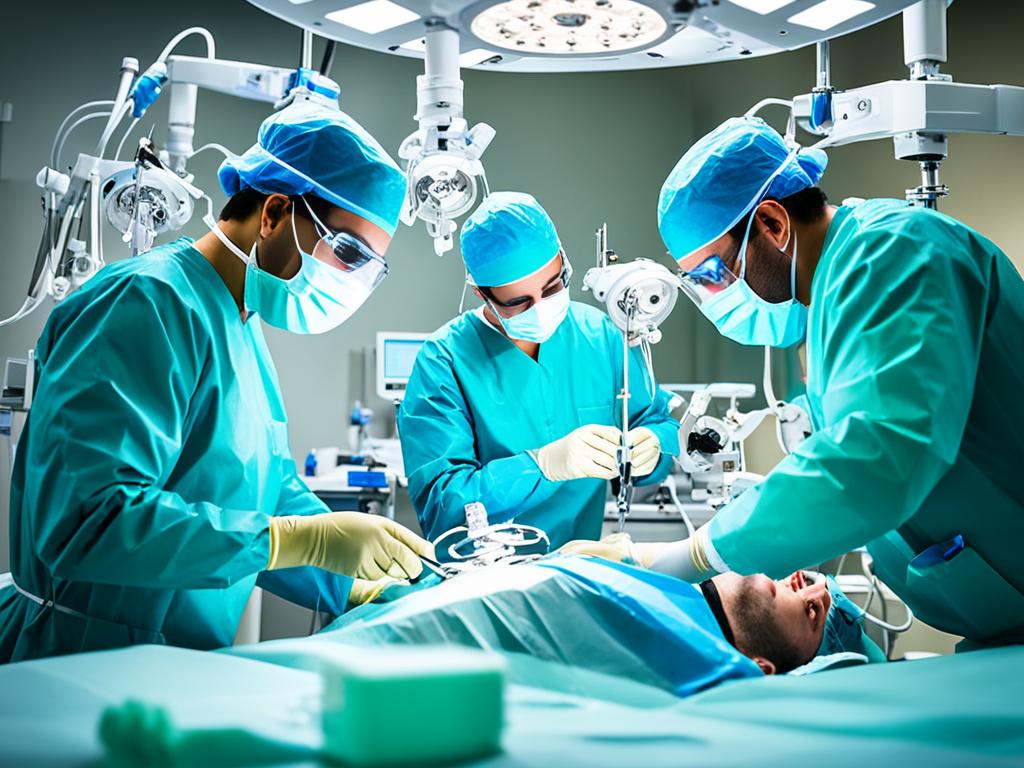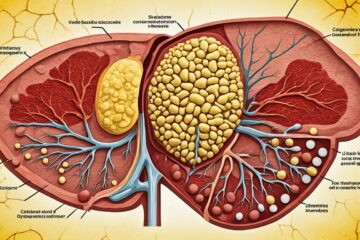Struggling with stomach ulcers that won’t go away? If standard treatments have failed, it might be time to consider surgery. Let’s explore what stomach ulcer surgery is about. We will also look at what the recovery process involves.
Stomach ulcers can really disrupt your life. Despite trying different treatments, some ulcers just won’t heal. This is where surgery comes in. But, before choosing this path, it’s critical to know what surgeries are out there. We’ll also cover possible issues that might come up.
Today, surgery for stomach ulcers offers hope. This article will explain the various surgical techniques and their pluses. We’ll talk about what to expect while recuperating. Plus, we’ll go over any risks of the surgery. This knowledge will help you decide what’s best for you.
Key Takeaways:
- For non-responsive stomach ulcers, surgery is a good option.
- Different surgeries exist, such as gastrectomy and repair of perforations, aiming to better stomach function.
- Recovery time varies based on surgery type and ulcer severity.
- Possible post-surgery problems are infection, bleeding, and stomach troubles.
- It’s vital to follow aftercare advice and keep all check-up appointments.
Different Surgeries for Stomach Ulcers
There are five surgeries that often help with stomach ulcers. These options are for people who don’t get better with medicine. Each surgery has its goal. They aim to remove and repair ulcers to keep patients healthy for a long time.
Graham Patch
The Graham patch is the first choice for treating stomach ulcers. This ulcer removal procedure is for sealing a hole in the stomach. Doctors use part of the peritoneum to cover the hole. This stops further problems.
Subtotal Gastrectomy
Subtotal gastrectomy is for stomach parts badly affected by ulcers. This stomach ulcer operation removes the damaged part. Doctors then connect the cut stomach parts. This helps remove the cause of ulcers and aids healing.
Vagotomy
Vagotomy is a surgery to reduce stomach acid levels. It involves cutting parts of the vagus nerve. Less acid helps prevent new ulcers and speed up healing.
Antrectomy
Antrectomy removes the part of the stomach that makes a lot of acid. This stomach ulcer operation aims to lower acid production. It’s done to stop ulcers from getting worse or forming.
Pyloroplasty
Pyloroplasty helps widen the stomach’s end to lessen acid reflux. This surgical option for stomach ulcers improves how food moves. By doing this, it supports ulcer healing and lowers the risk of other problems.
These surgeries can be done with small incisions or larger ones. The way they’re done depends on the patient and the ulcer’s condition. It’s often based on what the doctor thinks is best for the patient’s health.
Knowing about the surgical options for stomach ulcers helps doctors pick the right treatment. With the best surgery, patients improve and enjoy a better life.
| Surgical Option | Description |
|---|---|
| Graham Patch | Repair perforation by suturing omentum over the hole |
| Subtotal Gastrectomy | Removal of affected part of the stomach and stitching cut ends together |
| Vagotomy | Cutting or resecting branches of the vagus nerve to reduce stomach acid production |
| Antrectomy | Removal of the lower third of the stomach that produces gastrin |
| Pyloroplasty | Widening the stomach’s lower opening to regulate food flow and prevent acid reflux |
Recovery and Complications
The time it takes to recover from a stomach ulcer varies. It depends on the ulcer’s size, its cause, and if there are any complications afterwards. Usually, most stomach ulcers heal in 4-8 weeks with the right treatment. But, some bigger ulcers might need up to 12 weeks to heal.
After surgery for a stomach ulcer, complications can happen. These include infections, bleeding, and problems from new holes or injuries to your digestive system. You might feel pain, have a fever, feel sick to your stomach, or have trouble digesting food.
It’s very important to follow your doctor’s advice for a good recovery. Make sure you go to all your check-up appointments. If you notice any strange symptoms while healing, talk to your doctor right away. They can help figure out what’s going on and how to treat it.




